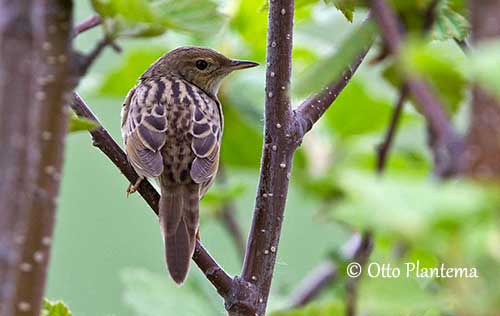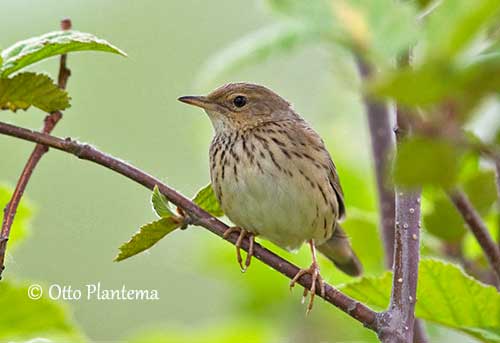
Fr: Locustelle lancéolée
Ang: Lanceolated Warbler
All: Strichelschwirl
Esp: Buscarla Lanceolada
Ita: Locustella lanceolata
Nd: Kleine Sprinkhaanzanger
Sd: Träsksångare
Photographer:
Otto Plantema
Trips around the world
Text by Nicole Bouglouan
Sources:
HANDBOOK OF THE BIRDS OF THE WORLD Vol 11 by Josep del Hoyo, Andrew Elliott and David Christie - Lynx Edicions - ISBN: 849655306X
THE HANDBOOK OF BIRD IDENTIFICATION FOR EUROPE AND THE WESTERN PALEARCTIC by Mark Beaman, Steve Madge - C. Helm - ISBN: 0713639601
A Field Guide to the Birds of South-East Asia by Craig Robson. New Holland Publishers. ISBN: 9781780090498
What Bird-The ultimate Bird Guide (Mitchell Waite)
British Birds - Identification of Lanceolated Warbler
First Record of a Lanceolated Warbler in California
Lanceolated Warbler
Locustella lanceolata
Passeriformes Order – Locustellidae Family
INTRODUCTION:
The Lanceolated Warbler is an Old World warbler, formerly included in the family Sylviidae with the Palearctic grasshopper warblers of genus Locustella.
This small passerine breeds from N European Russia, through N Asia to Japan (Hokkaido). It migrates S and spends the winter in SE Asia.
The population is currently stable and not globally threatened.
DESCRIPTION OF THE BIRD:
Biometrics:
Length: 12 cm
Weight: 13 g
The Lanceolated Warbler is a small passerine with heavily marked plumage. The upperparts are strongly streaked dark, involving general dark appearance. The feathers are fringed olive-grey to ginger-brown, but crown and mantle feathers show well-defined black centres. Rump and uppertail-coverts are streaked dark too. The uppertail is olive-brown. The flight-feathers are narrowly edged olive-brown, whereas tertials and greater coverts show olive-brown fringes and blackish centres.
The underparts are washed grey-buff with whiter throat and belly. Flanks are mostly olive-brown. Lower throat, breast and flanks are streaked dark grey. The undertail-coverts are buff to warm brown, and show blackish central spot or streak.
On the head, the crown feathers are dark grey to greyish-black with dull paler fringes. The streaking is usually less heavy than on mantle. The nape shows dark streaking too. There is a pale buff supercilium, more or less visible.
The bill has dark brown upper mandible with pale cutting edges, whereas the lower mandible is pinkish with dark tip. The eyes are dark hazel-brown. Legs and feet are pale pink to pinkish-brown.

Male and female are similar.
The juvenile resembles adult but it is usually weakly streaked on sides of lower breast and upper flanks. The head is often unstreaked.
SUBSPECIES AND RANGE:
The Lanceolated Warbler has two subspecies.
L.l. lanceolata breeds from S Finland through Russia to extreme N Mongolia and NE China (Manchuria). Outside breeding season, it can be found in NE Indian Subcontinent, SE Asia and N Philippines, S to Sumatra and W Java.
L.l. hendersonii breeds on Sakhalin Islands, S Kuril Island and N Japan (Hokkaido). It occurs in SE Asia during the non-breeding season.
This race is slightly paler on the upperparts, with weaker streaking. The underparts are more varied with less conspicuous markings. Flanks and undertail-coverts are warm buff. Adult and juvenile show sometimes yellow wash below.
HABITAT:
The Lanceolated Warbler usually breeds in moist, grassy meadows with scattered bushes, by water such as streams and lakes, and on marsh edges, in forest clearings with scattered scrub or small trees, and in damp valleys.
Outside breeding season, both on migration and during winter, it occurs in marshes, and frequents scrub and bushes around reedbeds. It is also found in wet grassland, emergent vegetation of waterbodies and ditches, and in ricefields.
In SE Asia, it frequents grass, weeds and scrubs, often in marshy areas. It also occurs at the edges of cultivated fields and up to 1800 metres of elevation.
CALLS AND SONGS: SOUNDS BY XENO-CANTO
The Lanceolated Warbler’s calls include several sound types such as a sharp “pit”, a quiet “tack”, a low “chirr-chirr”, a harsh scolding “cheek” often repeated, and a trilled “rit-tit-tit-tit”.
The song is a prolonged insect-like trill, a sustained “zizizizizizizi…”
BEHAVIOUR IN THE WILD:
The Lanceolated Warbler feeds on invertebrates including insects and their larvae (Coleopterans), ants (Hymenopterans) and spiders. It also consumes seeds according to the season.
This species is very skulking and occurs on or near the ground, running and hopping among grasses. It often flicks the wings. It usually creeps through the vegetation and is difficult to flush and to see except sometimes when singing. It often allows a very close approach.

During the breeding season, the Lanceolated Warbler nests solitary and becomes territorial. Both mates are probably monogamous.
During disputes, the birds sing loudly and perform threat displays, chasing and fighting. During the close encounters, the males often point both head and body horizontally at each other, while their plumage is ruffled, the tail is spread and the slightly raised wings are vibrating.
The Lanceolated Warbler is a long-distance migrant. It leaves the breeding grounds in Siberia in mid-July/late July, and the W breeders move SE.
They leave N Japan in August-September and move SW through Korea.
The northern return migration starts in April in Philippines and they reach their Russian breeding territories from mid-May, but mostly early June/mid-June in C and W Siberia.
The Lanceolated Warbler performs short flights with rapid wingbeats. When disturbed, the flight can be fast but it is low and appears weak, probably due to the rounded, short wings.
REPRODUCTION OF THIS SPECIES:
The breeding season takes place in spring, with the laying mid-June to late June.
The Lanceolated Warbler is solitary nester. The nest is well hidden in grass clump among grasses and leaves. It is a deep cup with thick structure, made with grass, leaves and moss, and lined with softer grasses.
The female lays 3-5 eggs and incubates alone during 12-14 days. The chicks leave the nest about 10-12 days after hatching.
PROTECTION / THREATS / STATUS:
The Lanceolated Warbler is locally common in the Siberian breeding range and in Hokkaido.
The European population (less than 5% of global range) was estimated to number 150,000/300,000 individuals in 2004. The population of the extreme W of the range (W of Urals) is small but increasing, and estimated to number 5500/6000 pairs in 1990s.
The Lanceolated Warbler is currently evaluated as Least Concern.